The Mikoyan MiG-29 (Russian: Микоян и Гуревич МиГ-29; NATO reporting name: "Fulcrum") is a fourth-generation jet fighter aircraft designed in the Soviet Union. Developed by the Mikoyan design bureau as an air superiority fighter during the 1970s, the MiG-29, along with the larger Sukhoi Su-27, was developed to counter new American fighters such as the McDonnell Douglas F-15 Eagle, and the General Dynamics F-16 Fighting Falcon.[6] The MiG-29 entered service with the Soviet Air Force in 1983.
While originally oriented towards combat against any enemy aircraft, many MiG-29s have been furnished as multirole fighters capable of performing a number of different operations, and are commonly outfitted to use a range of air-to-surface armaments and precision munitions. The MiG-29 has been manufactured in several major variants, including the multirole Mikoyan MiG-29M and the navalised Mikoyan MiG-29K; the most advanced member of the family to date is the Mikoyan MiG-35. Later models frequently feature improved engines, glass cockpits with HOTAS-compatible flight controls, modern radar and IRST sensors, considerably increased fuel capacity; some aircraft have also been equipped for aerial refuelling.
Following the dissolution of the Soviet Union, a number of successor states have continued to operate the MiG-29; the largest of which is the Russian Air Force. The Russian Air Force wanted to upgrade its existing fleet to the modernised MiG-29SMT configuration, but financial difficulties have limited deliveries. The MiG-29 has also been a popular export aircraft; over 30 individual nations either operate or have previously operated the aircraft to date, India being one of the largest export operators of the type. As of 2013, the MiG-29 is in production by Mikoyan, a subsidiary of United Aircraft Corporation (UAC) since 2006.
Origins
In the late 1960s, the United States Air Force started the "F-X" program, which led to the McDonnell Douglas F-15 Eagle being ordered for production in late 1969.[7] At the height of the Cold War, a Soviet response was necessary to avoid the possibility of a new American fighter gaining a serious technological advantage over existing Soviet fighters. Thus the development of a new air superiority fighter became a priority.[6] In 1969, the Soviet General Staff issued a requirement for a Perspektivnyy Frontovoy Istrebitel (PFI, translating directly as "Perspective Frontline Fighter", roughly "Advanced Frontline Fighter").[8] Specifications were extremely ambitious, calling for long range, good short-field performance (including the ability to use austere runways), excellent agility, Mach 2+ speed, and heavy armament. The Russian aerodynamics institute TsAGI worked in collaboration with the Sukhoi design bureau on the aircraft's aerodynamics.[8]However, in 1971 Soviet studies determined the need for different types of fighters. The PFI program was supplemented with the LPFI (Perspektivnyy Lyogkiy Frontovoy Istrebitel, or "Advanced Lightweight Tactical Fighter") program; the Soviet fighter force was planned to be approximately 33% PFI and 67% LPFI.[9] PFI and LPFI paralleled the USAF's decision that created the "Lightweight Fighter" program and the General Dynamics F-16 Fighting Falcon and Northrop YF-17.[10] The PFI fighter was assigned to Sukhoi, resulting in the Sukhoi Su-27, while the lightweight fighter went to Mikoyan. Detailed design work on the resultant Mikoyan Product 9, designated MiG-29A, began in 1974, with the first flight taking place on 6 October 1977. The pre-production aircraft was first spotted by United States reconnaissance satellites in November of that year; it was dubbed Ram-L because it was observed at the Zhukovsky flight test center near the town of Ramenskoye.[11][12] Early Western speculations suggested that the Ram-L was very similar in appearance to the YF-17 and powered by afterburning Tumansky R-25 turbojets.[citation needed]
Despite program delays caused by the loss of two prototypes in engine-related accidents (third prototype on 15 June 1978 and the fifth prototype on 31 October 1980), the MiG-29B production version entered service in August 1983 at the Kubinka air base. State acceptance trials were completed in 1984, and deliveries began the same year to the Soviet Frontal Aviation.[citation needed]
The workload split between TPFI and LPFI became more apparent as the MiG-29 filtered into front line service with the Soviet Air Forces (Russian: Voenno-Vozdushnye Sily [VVS]) in the mid-1980s. While the heavy, long range Su-27 was tasked with the more exotic and dangerous role of deep air-to-air sweeps of NATO high-value assets, the smaller MiG-29 directly replaced the MiG-23 in the frontal aviation role. Features such as rugged landing gear and protective intake grates allowed MiG-29 operations from damaged or under-prepared airstrips that Soviet war planners expected to encounter during a rapid armored advance. The MiG-29 was to be an escort for local strike and interdiction air packages, protecting vulnerable ground attack aircraft from NATO fighters such as the F-15 and F-16.[citation needed]
Introduction and improvements
In the West, the new fighter was given the NATO reporting name "Fulcrum-A" because the pre-production MiG-29A, which should have logically received this designation, remained unknown in the West at that time. The Soviet Union did not assign official names to most of its aircraft, although nicknames were common. Unusually, some Soviet pilots found the MiG-29’s NATO reporting name, "Fulcrum", to be a flattering description of the aircraft’s intended purpose, and it is sometimes unofficially used in Russian service.[13]The MiG-29B was widely exported in downgraded versions, known as MiG-29B 9-12A and MiG-29B 9-12B for Warsaw Pact and non-Warsaw Pact nations respectively, with less capable avionics and no capability for delivering nuclear weapons. Total production was about 840 aircraft.[citation needed]
In the 1980s, Mikoyan developed the improved MiG-29S to use longer range R-27E and R-77 air-to-air missiles. It added a dorsal 'hump' to the upper fuselage to house a jamming system and some additional fuel capacity. The weapons load was increased to 4,000 kg (8,800 lb) with airframe strengthening. These features were included in new-built fighters and upgrades to older MiG-29s.[14][15]
Refined versions of the MiG-29 with improved avionics were fielded by the Soviet Union, but Mikoyan’s multirole variants, including a carrier-based version designated MiG-29K, were never produced in large numbers. In the post-Soviet era, MiG-29 development was influenced by the Mikoyan bureau's apparent lesser political clout than rival Sukhoi. Some more advanced versions are still being pursued for export, and updates of existing Russian aircraft are likely. New fighter versions called MiG-29M/M2 and MiG-29SMT have been developed. Furthermore, development of the MiG-29K carrier version has been resumed for the Indian Navy's INS Vikramaditya, and Russian Navy's Admiral Kuznetsov class aircraft carrier.
Powerplant and range
Main article: Klimov RD-33
The MiG-29 has two widely spaced Klimov RD-33 turbofan engines, each rated at 50.0 kN (11,240 lbf) dry and 81.3 kN (18,277 lbf) in afterburner. The space between the engines generates lift, thereby reducing effective wing loading, to improve maneuverability. The engines are fed through wedge-type intakes fitted under the leading-edge extensions (LERXs), which have variable ramps to allow high-Mach
speeds. As an adaptation to rough-field operations, the main air inlet
can be closed completely and alter using the auxiliary air inlet on the
upper fuselage for takeoff, landing and low-altitude flying, preventing ingestion of ground debris.
Thereby the engines receive air through louvers on the LERXs which open
automatically when intakes are closed. However the latest variant of
the family, the MiG-35,
eliminated these dorsal louvers, and adopted the mesh screens design in
the main intakes, similar to those fitted to the Su-27.[16]The MiG-29 has a ferry range of 1,500 km without external fuel tanks, and 2,100 km with one external tank.[17] The internal fuel capacity of the original MiG-29B is 4,365 litres distributed between six internal fuel tanks, four in the fuselage and one in each wing. For longer flights, this can be supplemented by a 1,500-litre (330 Imp gal, 395 US gal) centreline drop tank and, on later production batches, two 1,150-litre (253 Imp gal, 300 US gal) underwing drop tanks. In addition, a small number have been fitted with port-side inflight refueling probes, allowing much longer flight times by using a probe-and-drogue system. Some MiG-29B airframes have been upgraded to the "Fatback" configuration (MiG-29 9–13), which adds a dorsal-mounted internal fuel tank. Advanced variants, such as the MiG-35, can be fitted with a conformal fuel tank on the dorsal spine, although none of them have yet entered service.[citation needed]
Cockpit
The cockpit features a conventional centre stick and left hand throttle controls. The pilot sits in a Zvezda K-36DM zero-zero ejection seat which has had impressive performance in emergency escapes.The cockpit has conventional dials, with a head-up display (HUD) and a Shchel-3UM helmet mounted display, but no HOTAS ("hands-on-throttle-and-stick") capability. Emphasis seems to have been placed on making the cockpit similar to the earlier MiG-23 and other Soviet aircraft for ease of conversion, rather than on ergonomics. Nonetheless, the MiG-29 does have substantially better visibility than most previous Russian jet fighters, thanks to a high-mounted bubble canopy. Upgraded models introduce "glass cockpits" with modern liquid-crystal (LCD) multi-function displays (MFDs) and true HOTAS.
Sensors
The baseline MiG-29B has a Phazotron RLPK-29 (Radiolokatsyonnui Pritselnui Kompleks) radar fire control system which includes the N019 (Sapfir 29; NATO: 'Slot Back') look-down/shoot-down coherent pulse-Doppler radar and the Ts100.02-02 digital computer. Tracking range against a fighter-sized target was only about 70 km (38 nmi) in the frontal aspect and 35 km (19 nmi) in the rear aspect. Range against bomber-sized targets was roughly double. Ten targets could be displayed in search mode, but the radar had to lock onto a single target for semi-active homing (SARH). The MiG-29 was not able to reliably utilize the new Vympel R-27R (NATO: AA-10 "Alamo") long-range SARH missile at its maximum ranges.[citation needed]These performance deficiencies were largely due to the N019 radar not being a new design. Instead, the system was a further development of the architecture already used in Phazotron's Sapfir-23ML system, then in use on the MiG-23ML. During the initial MiG-29 design specification period in the mid-1970s, Phazotron NIIR was tasked with producing a modern radar for the MiG-29. To speed development, Phazotron based its new design on the work undertaken by NPO Istok on the experimental "Soyuz" radar program. Accordingly, the N019 was originally intended to have a flat planar array antenna and full digital signal processing, giving a detection and tracking range of at least 100 km against a fighter-sized target. Testing and prototypes soon revealed this could not be attained in the required timeframe, at least not in a radar that would fit in the MiG-29's nose. Rather than design a completely new, albeit more modest radar, Phazotron reverted to a version of the twisted-polarization Cassegrain antenna used successfully on the Sapfir-23ML to save time and cost. This system used the same analog signal processors as their earlier designs, coupled with a NII Argon-designed Ts100 digital computer. While this decision provided a working radar system for the new fighter, it inherited all of the weak points of the earlier design. This reliance on 1960s-era technology continued to plague the MiG-29's ability to detect and track airborne targets at ranges available with the R-27 and R-77 missiles, although new designs like the digital N010 Zhuk-M address the serious signal processing shortcomings inherent in the analog design. Most MiG-29 continue to use the analog N019 or N019M radar, although VVS has indicated its desire to upgrade all existing MiG-29s to a fully digital system.
The N019 was further compromised by Phazotron designer Adolf Tolkachev’s betrayal of the radar to the CIA, for which he was executed in 1986. In response to all of these problems, the Soviets hastily developed a modified N019M Topaz radar for the upgraded MiG-29S aircraft. However, VVS was reportedly still not satisfied with the performance of the system and demanded another upgrade. The latest upgraded aircraft offered the N010 Zhuk-M, which has a planar array antenna rather than a dish, improving range, and a much superior processing ability, with multiple-target engagement capability and compatibility with the Vympel R-77 (or RVV-AE) (NATO: AA-12 'Adder'). A useful feature the MiG-29 shares with the Su-27 is the S-31E2 KOLS, a combined laser rangefinder and IRST in an "eyeball" mount forward of the cockpit canopy. This can be slaved to the radar or used independently, and provides exceptional gun-laying accuracy.[citation needed]
Armament
Variants
There are currently several upgrade programmes conducted by the Russian Air Force for MiG-29 fighters which envisage: upgrading of the avionics suite to comply with NATO / ICAO (www.icao.int) standards, extension of the aircraft service life to 4,000 flight hours (40 years), upgrading combat capabilities and reliability, safety enhancements. In 2005 the Russian Aircraft Corporation “MiG” started production of new unified family of multirole fighters of the 4++ generation (aircraft-carrier based MiG-29K, front-line MiG-29M and MiG-35 fighters).- MiG-29 (Product 9.12)
- Initial production version; entered service in 1983. NATO reporting code is "Fulcrum-A".
- MiG-29B-12 (Product 9.12A)
- Downgraded export version for Warsaw Pact (9.12A) and non-Warsaw Pact nations (9.12B). Lacked a nuclear weapon delivery system and possessed downgraded radar, ECM and IFF. NATO reporting code is "Fulcrum-A".
- MiG-29UB-12 (Product 9.51)
- Twin seat training model. Infra-red sensor mounted only, no radar. NATO reporting code is "Fulcrum-B".
- MiG-29S
- The MiG-29S, given the NATO reporting code "Fulcrum-C", features flight control system improvements; a total of four new computers provide better stability augmentation and controllability with an increase of 2° in angle of attack (AoA). An improved mechanical-hydraulic flight control system allows for greater control surface deflections. The MiG-29S has a dorsal hump, which led to its nickname "Fatback", houses the L-203BE Gardenyia-1 ECM system. The MiG-29S can carry 1,150 liter (304 US gallon, 2,000 lb) under wing drop tanks and a centerline tank. The inboard underwing hardpoints allow a tandem pylon arrangement for carrying a larger payload of 4,000 kg (8,820 lb). Overall maximum gross weight has been raised to 20,000 kg (44,000 lb).
- Changes to the armaments include new longer-range air-to-air missiles like the R-27E (AA-10 "Alamo") and R-77 (AA-12 "Adder"); as well minor alterations to the cartridge ejection system of the GSh-30-1 cannon. Early MiG-29S featured an IRST sighting system; the MiG-29S improvement kit includes the Phazotron N019M radar and Built-In Test Equipment (BITE) to reduces dependence on ground support equipment; MiG MAPO designates this as MiG-29SD. Improvements to the MiG-29S's software and processing capabilities enables the tracking of up to 10 targets and the simultaneous engagement of two with the R-77 missile. The MiG-29S also has a limited ground-attack capability.
- MiG-29SE
- Export model MiG-29S except with slightly downgraded N-019ME radar with multiple target tracking ability and AAM-AE compatibility. The first export model MiG-29 with underwing drop tanks; the inner underwing pylons can carry over 500 kg bombs in side by side tandem pairs. Its weapons mix includes R-27T1, R-27ER1 and R-27ET1 medium-range missiles. The aircraft can be fitted with active ECM systems, weapons guidance aids, improved built-in check and training systems. The MiG-29SE can simultaneously engage two air targets.
- MiG-29S-13 (Product 9.13)
- MiG-29 variant similar to the 9.12, but with an enlarged fuselage spine containing additional fuel and a Gardeniya active jammer. Product 9.13S is also version with the same airframe as the 9.13, but with an increased external weapons load of 4,000 kg, and provision for two underwing fuel tanks. Radar upgraded to N019ME, providing an ability to track 10 targets and engage two simultaneously. Compatible with the Vympel R-77 (AA-12 "Adder") air-to-air missile (similar to the AIM-120 AMRAAM). NATO reporting code is "Fulcrum-C".
- MiG-29SM (Product 9.13M)
- Similar to the 9.13, but with the ability to carry guided air-to-surface missiles and TV- and laser-guided bombs. NATO reporting code is "Fulcrum-C".
- MiG-29G/MiG-29GT
- It was an upgrade standard for the German Air Force's MiG-29 / 29UB, inherited from the former East Germany to the NATO standards. Works was done by MiG Aircraft Product Support GmbH (MAPS), a joint venture company form between MiG Moscow Aviation Production Association and DaimlerChrysler Aerospace in 1993.[101]
- MiG-29AS/MiG-29UBS (MiG-29SD)
- Slovak Air Force performed an upgrade on their MiG-29/-29UB for NATO compatibility. Work is done by RAC MiG and Western firms, starting from 2005. The aircraft now has navigation and communications systems from Rockwell Collins, an IFF system from BAE Systems, new glass cockpit features multi-function LC displays and digital processors and also fitted to be integrate with Western equipment in the future. However, the armaments of the aircraft remain unchanged. 12 out of 21 of the entire MiG-29 fleet were upgraded and had been delivered as of late February 2008.[102]
- MiG-29 Sniper
- Upgrade planned for Romanian Air Force, by Israeli firms. First flight occurred on 5 May 2000. The program was halted along with the retiring of Romanian MiG-29s in 2003. The latter occurred because of high maintenance costs, which led to the Romanian Government's decision to halt the MiG-29 program and further invest in the MiG-21 LanceR program.
- MiG-29M / MiG-33 (Product 9.15)
Main article: Mikoyan MiG-29M
- Advanced multirole variant, with a redesigned airframe, mechanical flight controls replaced by a fly-by-wire system and powered by enhanced RD-33 ser.3M engines. NATO reporting code is "Fulcrum-E".
- MiG-29UBM (Product 9.61)
- Two-seat training variant of the MiG-29M. Never built. Effectively continued under the designation 'MiG-29M2'.
- MiG-29K (Product 9.31)
Main article: Mikoyan MiG-29K
- Naval variant based on MiG-29M, the letter "K" stands for "Korabelnogo bazirovaniya" (Deck-based ), with equipment such as folding wings, arrestor gear, and reinforced landing gear. Originally intended for the Admiral Kuznetsov class aircraft carriers, had even received series production approval from Russian Ministry of Defence but was later grounded in 1992 due to shift in military doctrine and state financial difficulty.[103] MiG Corporation restarted the program in 1999 and made vital improvement to the previous design. On 20 January 2004, Indian Navy signed a contract of 12 single-seat MiG-29K and four two-seat MiG-29KUB.[103] Modifications were made for Indian Navy requirement, now standard for all current production. Current production MiG-29K and MiG-29KUB also share a two-seater size canopy. The MiG-29K has radar absorbing coatings to reduce radar signature. Cockpit displays consist of wide HUD and three (seven on MiG-29KUB) colour LCD MFDs with a Topsight E helmet-mounted targeting system. It has a full range of weapons compatible with the MiG-29M and MiG-29SMT.[104] NATO reporting code is "Fulcrum-D".
- MiG-29KUB (Product 9.47)
- Identical characteristic to the MiG-29K but with tandem twin seat configuration. The design is to serve as trainer for MiG-29K pilot and is full combat capable. The first MiG-29KUB developed for the Indian Navy made its maiden flight at the Russian Zhukovsky aircraft test centre on 22 January 2007.[105] NATO reporting code is "Fulcrum-D".
- MiG-29SMT (Product 9.17)
- The MiG-29SMT is an upgrade package of the first-generation MiG-29s (9.12 to 9.13) containing many enhancements intended for the MiG-29M. Additional fuel tanks in a further enlarged spine provide a maximum flight range of 2,100 km (on internal fuel). The cockpit has an enhanced HOTAS design, two 152 × 203 mm (6 × 8-inch) colour liquid crystal MFDs and two smaller monochrome LCDs. The upgraded Zhuk-ME radar provides similar features to the MiG-29M. The power plant are upgraded RD-33 ser.3 engines with afterburning thrust rated the same at 8,300 kgf (81.4 kN) each. The weapons load was increased to 4,500 kg on six underwing and one ventral hardpoints, with similar weapon choices as for the MiG-29M variant. The upgraded aircraft has also a painted path for non-Russian origin avionics and weapons.[106]
- MiG-29BM
- "The MiG-29BM (probably Belorussian Modernised, possibly Bolyshaya Modernizaciya – large modernization) is an upgrade to the MiG-29 conducted by the ARZ-558 aircraft repair plant in Baranovichi, Belarus. The MiG-29BM is a strike variant of the MiG-29 pure fighter, the Belarussian counterpart to the Russian MiG-29SMT." It includes improvements to weapons, radar, as well as adding non-retractable air-air refueling ability.[107]
- MiG-29UBT (Product 9.51T)
- SMT standard upgrade for the MiG-29UB. Namely users, Algeria and Yemen.[108][109]
- MiG-29UPG
- The Indian UPG version is similar to the SMT variant but differs by having a foreign-made avionics suite integrated within it, in the so called, "international avionics suite".[44] The weapons suite is the same as the SMT and K/KUB versions.[44] The design is a new modification intended for the MiG-29s used by Indian Air Force. It made its maiden flight on 4 February 2011. The standard includes the new Zhuk-M radar, new avionics, a IFR probe as well as new enhanced RD-33 series 3 turbojet engines. The modernization is part of a $900 million contract to upgrade the 69 fighters fleet.[110]
- MiG-29M2 / MiG-29MRCA
- Two-seat version of MiG-29M. Identical characteristics to MiG-29M, with a slightly reduced ferry range of 1,800 km.[111] RAC MiG presented in various air shows, including Fifth China International Aviation and Aerospace Exhibition (CIAAE 2004),[112] Aero India 2005,[113][114] MAKS 2005.[115] It was once given designation MiG-29MRCA for marketing purpose and now evolved into the current MiG-35.
- MiG-29SMP / MiG-29UBP
- Upgrade for the Peruvian Air Force MiG-29 fleet. In August 2008 a contract of US$ 106 million was signed with RAC MiG for this custom SMT upgrade of an initial batch of eight MiG-29, with a provision for upgrade of the remainder of the Peruvian MiG-29 fleet.[116] The single-seat version is designated SMP, whereas the twin-seat version is designated UBP.
- The SMP standard features an improved ECM suite, avionics, sensors, pilot interface, and a MIL-STD-1553 databus. The interfaces include improved IRST capabilities for enhanced passive detection and tracking as well as better off-boresight launch capabilities, one MFCD and HOTAS.[117] The N019M1 radar, a heavily modified and upgraded digital version of the N019 radar, is used instead of the standard N010 Zhuk-M used on the MiG-29SMT. The upgrade also includes a structural life-extension program (SLEP), the overhaul, upgrade of the original engines and the installation of an in-flight refuelling probe.[118]
- MiG-29OVT
- The aircraft is one of the six pre-built MiG-29Ms before 1991, later received thrust-vectoring engine and fly-by-wire technology. It served as a thrust-vectoring engine testbed and technology demonstrator in various air shows to show future improvement in the MiG-29M. It has identical avionics to the MiG-29M. The only difference in the cockpit layout is an additional switch to turn on vector thrust function. The two RD-133 thrust-vectoring engines, each features unique rotating nozzles which can provide thrust vector deflection in all directions. However, despite its thrust-vectoring, other specifications were not officially emphasized. The aircraft is being demonstrated along with the MiG-29M2 in various air shows around the world for potential export. The aircraft is usually used as an aerobatic demonstrator.[119]
- MiG-35
Main article: Mikoyan MiG-35
- A recently unveiled mature development of the MiG-29M/M2 and MiG-29K/KUB. NATO reporting code is "Fulcrum-F".
- General characteristics
- Crew: 1
- Length: 17.37 m (57 ft)
- Wingspan: 11.4 m (37 ft 3 in)
- Height: 4.73 m (15 ft 6 in)
- Wing area: 38 m² (409 ft²)
- Empty weight: 11,000 kg (24,250 lb)
- Loaded weight: 15,300 kg (33,730 lb)
- Max. takeoff weight: 20,000 kg (44,100 lb)
- Powerplant: 2 × Klimov RD-33 afterburning turbofans, 8,300 kgf (81.4 kN, 18,300 lbf) each
- Maximum speed: Mach 2.25 (2,400 km/h, 1,490 mph) At low altitude: Mach 1.25 (1,500 km/h, 930 mph)
- Range: 1,430 km (772 nmi, 888 mi) with maximum internal fuel[158]
- Ferry range: 2,100 km (1,300 mi) with 1 drop tank
- Service ceiling: 18,013 m (59,100 ft)
- Rate of climb: initial 330 m/s average 109 m/s 0–6000 m[159] (65,000 ft/min)
- Wing loading: 403 kg/m² (82 lb/ft²)
- Thrust/weight: 1.09
- 1 x 30 mm GSh-30-1 cannon with 150 rounds
- 7 Hard points: 6 x pylons under-wing, 1 x under fuselage
- Up to 3,500 kg (7,720 lb) of weapons including six air-to-air missiles — a mix of semi-active radar homing (SARH) and AA-8 "Aphid", AA-10 "Alamo", AA-11 "Archer", AA-12 "Adder", FAB 500-M62, FAB-1000, TN-100, ECM Pods, S-24 rockets, Kh-25, Kh-29


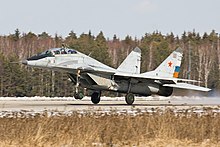

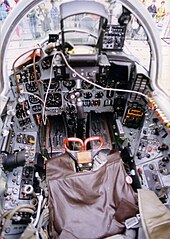

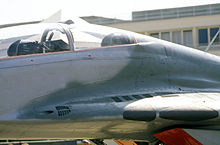









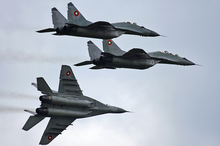





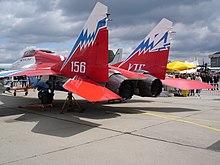
No comments:
Post a Comment